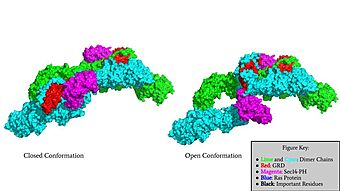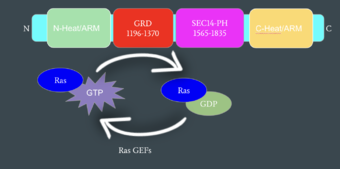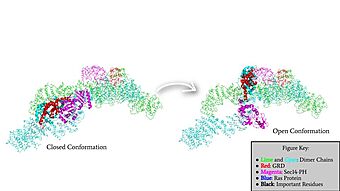Sandbox Reserved 1710
From Proteopedia
(Difference between revisions)
| Line 7: | Line 7: | ||
[[Image:Neurofibromin.jpg|340 px|right|thumb|Surface Rendering of Neurofibromin in its Open and Closed Conformation]] | [[Image:Neurofibromin.jpg|340 px|right|thumb|Surface Rendering of Neurofibromin in its Open and Closed Conformation]] | ||
Neurofibromin is a protein that is coded for by the [https://en.wikipedia.org/wiki/Neurofibromin_1 NF1 Gene] which is located on chromosome 17. It functions as a tumor suppressor gene through its association with the protein Ras. The molecular structure of Neurofibromin has been determined by [https://en.wikipedia.org/wiki/Cryogenic_electron_microscopy Cryo-Electron Microscopy]. The structure of neurofibromin isoform 2 by cryo-electron microscopy revealed different functional states for the Neurofibromin protein.<ref name="Naschberger">PMID:34707296</ref> Mutations in Neurofibromin is associated with diseases such as Plexiform Neurofibromas. | Neurofibromin is a protein that is coded for by the [https://en.wikipedia.org/wiki/Neurofibromin_1 NF1 Gene] which is located on chromosome 17. It functions as a tumor suppressor gene through its association with the protein Ras. The molecular structure of Neurofibromin has been determined by [https://en.wikipedia.org/wiki/Cryogenic_electron_microscopy Cryo-Electron Microscopy]. The structure of neurofibromin isoform 2 by cryo-electron microscopy revealed different functional states for the Neurofibromin protein.<ref name="Naschberger">PMID:34707296</ref> Mutations in Neurofibromin is associated with diseases such as Plexiform Neurofibromas. | ||
| + | |||
| + | == Function == | ||
| + | Neurofibromin functions as a tumor suppressor protein.<ref name="Trovó-Marqui">PMID:16813595</ref> Its job is to prevent cell growth by turning off another protein known as [https://en.wikipedia.org/wiki/Ras_GTPase Ras] which in its active state, stimulates cell growth and division. Ras is a GTPase membrane protein that can only interact with Neurofibromin, a cytoplasmic protein, in the open conformation of Neurofibromin. As Neurofibromin is a cytoplasmic protein, it is brought to the membrane to associate with Ras via another protein known as [https://medlineplus.gov/genetics/gene/spred1/ SPRED1]. Neurofibromin can interact with SPRED1 in both the open and closed conformations however, it can only associate with Ras when it is in its open conformation. The interaction between Neurofibromin and Ras occurs via an Arginine finger (R1276) present in the GRD domain of Neurofibromin which is critical for Ras binding. R1276 is only accessible for binding when the GRD and Sec14-PH domains are rotated into the open conformation and there is no steric hindrance from the surrounding dimer chains. When R1276 is able to associate with Ras, Neurofibromin downregulates the [https://en.wikipedia.org/wiki/MAPK/ERK_pathway Ras signaling pathway] by hydrolyzing the GTP associated with Ras to GDP, effectively making it inactive and inhibiting cell growth and division. | ||
| + | [[Image:mechanismofRas.png|340 px|right|thumb|Mechanism of Ras Regulation by Neurofibromin]] | ||
== Structure == | == Structure == | ||
| Line 19: | Line 23: | ||
[[Image:GRDandSec14PHRotation.jpg|340 px|left|thumb|Rotation of the GRD and Sec14-PH domains from the closed conformation of neurofibromin to the open conformation of neurofibromin to allow Ras binding. The GRD rotates -130° and the Sec14-PH domain rotates -90°]] | [[Image:GRDandSec14PHRotation.jpg|340 px|left|thumb|Rotation of the GRD and Sec14-PH domains from the closed conformation of neurofibromin to the open conformation of neurofibromin to allow Ras binding. The GRD rotates -130° and the Sec14-PH domain rotates -90°]] | ||
| - | + | ||
| - | + | ||
| - | + | ||
== Disease and Medical Relevance == | == Disease and Medical Relevance == | ||
Revision as of 18:59, 5 April 2022
| This Sandbox is Reserved from February 28 through September 1, 2022 for use in the course CH462 Biochemistry II taught by R. Jeremy Johnson at the Butler University, Indianapolis, USA. This reservation includes Sandbox Reserved 1700 through Sandbox Reserved 1729. |
To get started:
More help: Help:Editing |
Human Neurofibromin - The Tumor Suppressor Gene
| |||||||||||
References
- ↑ Naschberger A, Baradaran R, Rupp B, Carroni M. The structure of neurofibromin isoform 2 reveals different functional states. Nature. 2021 Nov;599(7884):315-319. doi: 10.1038/s41586-021-04024-x. Epub 2021, Oct 27. PMID:34707296 doi:http://dx.doi.org/10.1038/s41586-021-04024-x
- ↑ Trovo-Marqui AB, Tajara EH. Neurofibromin: a general outlook. Clin Genet. 2006 Jul;70(1):1-13. doi: 10.1111/j.1399-0004.2006.00639.x. PMID:16813595 doi:http://dx.doi.org/10.1111/j.1399-0004.2006.00639.x
- ↑ Lupton CJ, Bayly-Jones C, D'Andrea L, Huang C, Schittenhelm RB, Venugopal H, Whisstock JC, Halls ML, Ellisdon AM. The cryo-EM structure of the human neurofibromin dimer reveals the molecular basis for neurofibromatosis type 1. Nat Struct Mol Biol. 2021 Dec;28(12):982-988. doi: 10.1038/s41594-021-00687-2., Epub 2021 Dec 9. PMID:34887559 doi:http://dx.doi.org/10.1038/s41594-021-00687-2
- ↑ Abramowicz A, Gos M. Neurofibromin in neurofibromatosis type 1 - mutations in NF1gene as a cause of disease. Dev Period Med. 2014 Jul-Sep;18(3):297-306. PMID:25182393
- ↑ Ratner N, Miller SJ. A RASopathy gene commonly mutated in cancer: the neurofibromatosis type 1 tumour suppressor. Nat Rev Cancer. 2015 May;15(5):290-301. doi: 10.1038/nrc3911. Epub 2015 Apr 16. PMID:25877329 doi:http://dx.doi.org/10.1038/nrc3911



